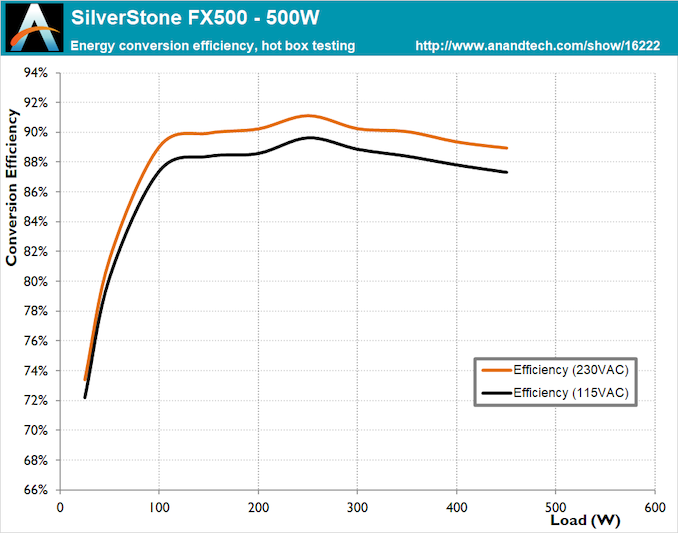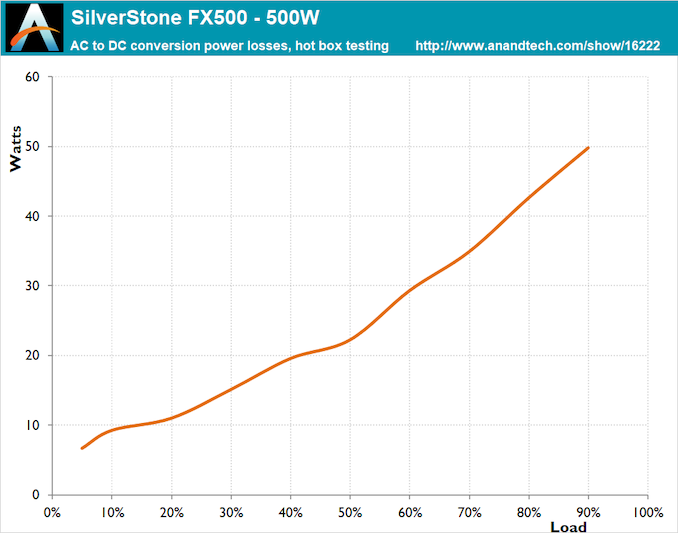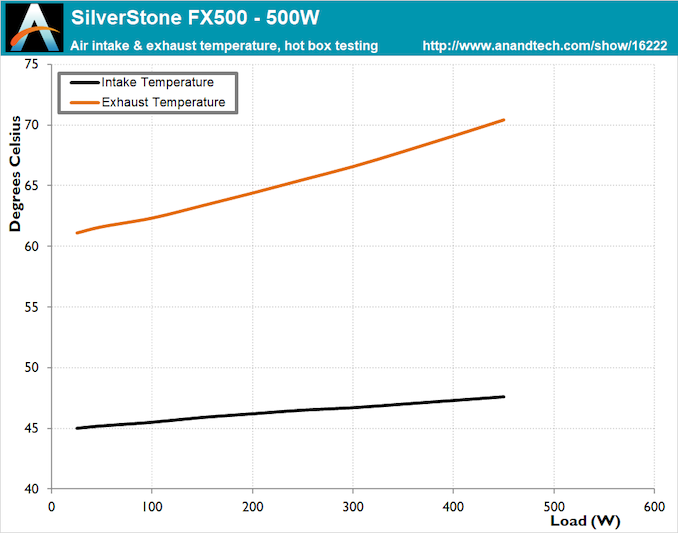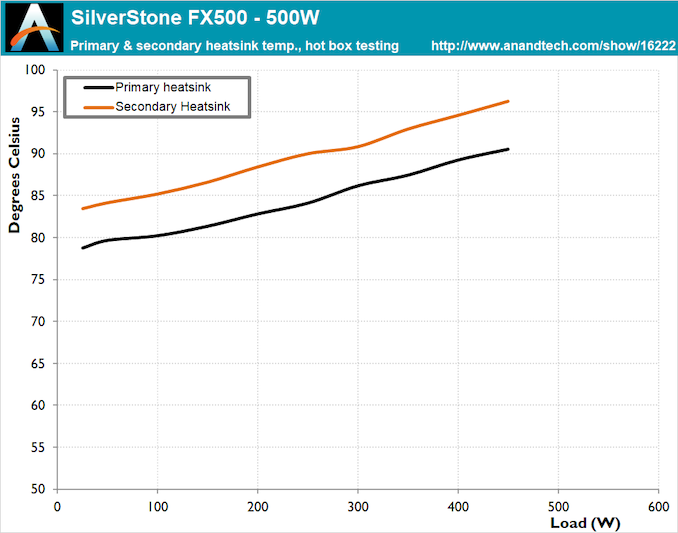The SilverStone FX500 Flex-ATX 500W PSU Review: Small Power Supply With a Big Bark
by E. Fylladitakis on November 12, 2020 9:00 AM EST- Posted in
- Cases/Cooling/PSUs
- PSUs
- 80Plus Gold
- SilverStone
- 500W
- Flex ATX
Hot Test Results
| Main Output | ||||||||
| Load (Watts) | 100.85 W | 251.53 W | 374.45 W | 497.73 W | ||||
| Load (Percent) | 20.17% | 50.31% | 74.89% | 99.55% | ||||
| Amperes | Volts | Amperes | Volts | Amperes | Volts | Amperes | Volts | |
| 3.3 V | 1.24 | 3.36 | 3.09 | 3.34 | 4.64 | 3.32 | 6.19 | 3.3 |
| 5 V | 1.5 | 5.1 | 3.76 | 5.07 | 5.64 | 5.02 | 7.51 | 5 |
| 12 V | 7.37 | 12.08 | 18.42 | 12.06 | 27.63 | 11.97 | 36.83 | 11.94 |
| Line | Regulation (20% to 100% load) |
Voltage Ripple (mV) | |||||
| 20% Load | 50% Load | 75% Load | 100% Load | CL1 12V |
CL2 3.3V + 5V |
||
| 3.3V | 2% | 14 | 20 | 20 | 28 | 16 | 34 |
| 5V | 1.8% | 16 | 22 | 26 | 34 | 20 | 40 |
| 12V | 1.2% | 20 | 24 | 28 | 60 | 52 | 38 |
As can be seen in the preceding tables, the power quality of the SilverStone FX500 is good. The maximum voltage ripple on the 12V line is 60 mV, a figure that most high-end PSU admittedly surpass nowadays, but it's still exactly half of the ATX design guide's recommended 120 mV limit. Ripple on the secondary 3.3V/5V lines is equally mediocre, reaching 34 mV on the 5V line with a recommended maximum at 50 mV. Voltage regulation is good, at just 1.2% for the main 12V line and about 2% for the secondary 3.3V/5V lines.
Operation in high ambient temperatures greatly affects the performance of the tiny FX500. First and foremost, the PSU was unable to output all of its rated power output under these operating conditions, shutting down some minutes after the load was set at 500 Watts due to overheating. Taking the reduced nominal load range of between 20% and 90% into account, the average efficiency drops by 0.6% regardless of the input voltage, going down to an average of 89.9% (230 VAC) / 88.4% (115 VAC), figures that initially seem comparatively good but are deceptive due to the missing 100% load measurement.
As it can be derived from the charts below, the cooling capabilities of the SilverStone FX500 are unable to cope with the very adverse ambient conditions inside our hotbox. Although it operated normally at 100% for several minutes, it eventually shut down to protect itself. Given that our testing temperatures are higher than the 40°C that this unit is rated for, the FX500 held fairly well considering its small size. The real weakness here is that the small cooling fan is operating at maximum speed practically all the time. With noise figures constantly above 50 dB(A), the FX500 will be unbearably loud for home users under such operating conditions.















35 Comments
View All Comments
RealBeast - Thursday, November 12, 2020 - link
Doh, this looked promising for a small custom HTPC build until I read the sound issue.Lucky Stripes 99 - Thursday, November 12, 2020 - link
If you are looking for a nearly silent PSU for a SFF HTPC, good luck finding one. Almost all of the FlexATX PSUs use little 40mm fans that struggle to move air quietly. Even the 160W unit in my Inwin Chopin case was noticeable when using it as a HTPC. So I pulled the original PSU and replaced it with a fanless 12V DC-DC ATX pico-PSU style board paired with a 220W 12V laptop brick. Since the majority of the work is being done outside of the case, the Noctua HSF atop my AMD 3400g is enough to keep the DC-DC board cool. The downside of a pico-PSU style board is that it is a tight fit near my memory modules, but since nobody makes a FlexATX sized DC-DC supply outside of some stupidly expensive ($200+) industrial models, it was the route I was stuck with.rabw - Friday, November 13, 2020 - link
If you have room for a SFX PSU, the Corsair SF750 is passive up to 300W.Valantar - Friday, November 13, 2020 - link
There are options, but you need to abandon traditional form factors. I just built a silent, semi-fanless Renoir HTPC using a MeanWell RPS-200-12C AC-12VDC PSU plus a plug-in DC-ATX board. The PSU can run on convection cooling up to ~150w, which far outstrips the needs of my 4650G.Still, the market for this Silverstone unit is more for the people buying SFF cases off TaoBao - there are dozens if not hundreds of designs there for FlexATX PSUs and relatively large GPUs, and until now the only real PSU option has been refurbished server units. I'm expecting a lot of these will get Noctua fan swaps in short order though.
DanNeely - Thursday, November 12, 2020 - link
There's no way to move a meaningful amount of air with a 40mm fan that's not going to be loud.Sadly, it doesn't appear to have a low power fanless level. At least 50-100W should be doable (maybe a bit more); that's a mainstream laptop power brick, and if being inside a case means this won't have as easy passive cooling it's also several times larger than a brick.
MenhirMike - Friday, November 13, 2020 - link
If you only need 50-100W, then a PicoPSU is a great option. Looks like they have models that go up to 160W, I myself have an 80W Model (only with a 60W laptop power brick though) and it does what it needs to do.DanNeely - Friday, November 13, 2020 - link
If you never need more than that much power, then yes something like this would always be the wrong choice. ~100W before the fan came on would be for an SFF system with a discrete GPU that was near silent at idle and only made noise under load.Lucky Stripes 99 - Friday, November 13, 2020 - link
There are now numerous PicoPSU clones on the market with much higher peak wattage. HDPlex has 200W models, RGeek has 250W models, and G-Unique has 450W models.meacupla - Friday, November 13, 2020 - link
You can add an 80mm fan to the side if you cut a hole into the side of it.Of course, it's no longer Flex ATX sized at that point, but it's still smaller than an SFX PSU.
There are also TFX PSUs, but they tend to lag even further behind than Flex when it comes to higher power output.
Spunjji - Friday, November 13, 2020 - link
If you're after something quiet and don't need high power output then FSP make a 150W fanless model, the FSP150-50FGBBB. It doesn't have a lot of connectors, though, so you'd need to plan a build accordingly.